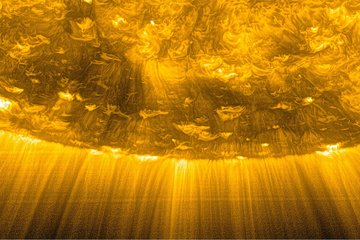How strongly does the solar ultraviolet radiation vary?
Understanding the sources of the solar brightness variations in the UV
The climate on Earth has undergone a dramatic change over the last century. The dominant supplier of energy into the complex climate system is the Sun. It affects Earth's climate through the variation of both its total brightness and its spectrum, especially in the UV range. Solar UV radiation at 200-400 nm not only heats Earth's atmosphere but also governs its chemistry, including the ozone balance. Yet, solar variability in the critical wavelength range between 200 and 400 nm is most uncertain. This is because observations of the Sun in this range are challenging and sparse.
On much shorter timescales, minutes to hours, sudden outbursts of radiation on the surface of the Sun, called solar flares, often also accompanied by the expulsion of material, known as a coronal mass ejection, can cause radiations storms and harm satellites, communication systems, power grids and other technologies. Of particular interest for humanity is the question of how often the Sun unleashes ‘superflares’ which are much more energetic than the usual solar flares. While the period of direct solar observations is too short to answer this question, an exciting possibility to answer it is brought by the observations of solar analogues, i.e. stars very similar to the Sun. The Kepler and TESS space telescopes have revealed that many of them experience superflares with estimated energies several orders of magnitude larger than what we know for the Sun. However, stellar and solar flare cannot be compared directly as solar flares are usually observed in X-rays and extreme UV, while stellar data are mostly in the visible part of the spectrum. Thus, observations of flares in the UV range would be crucial to bridge the gap between the two individual pieces of information.
The missing information now starts arriving, and we are in a lucky situation to have access to these unique data. Aditya-L1, the first Indian solar physics mission, launched in 2023 carries the Solar Ultraviolet Imaging Telescope (SUIT). SUIT provides first ever full-disc solar images of the Sun in 3 broad- and 8 narrowband filters in the wavelength range 200-400 nm covering solar photosphere and chromosphere. The international balloon-borne solar observatory Sunrise had its highly successful third flight (Sunrise III) in July 2024. Sunrise Ultraviolet Spectropolarimetric Imager, SUSI, onboard Sunrise III observed the wavelength range 300-420 nm at a resolution as small as 50 km on the Sun.
The main aim of the PhD projects in this field is to gain better understanding of the variability of the solar brightness in the UV as well as of its sources, using the unique data from Aditya-L1 and Sunrise III missions, complemented with Solar Orbiter, Solar Dynamics Observatory and ground-based Ca II K observations.














